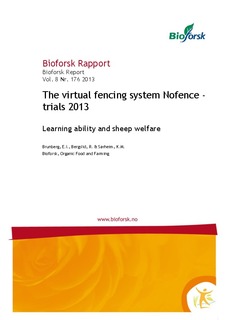| dc.description.abstract | NoFence is a GPS-based virtual fencing system to be used for grazing animals. Each animal wears a collar and if crossing a predefined border, the animal will get a sound warning followed by an electric shock. The aims with the two experiments reported in this report were to: 1. To test Nofence on sheep with young lambs focusing on animal welfare and learning. 2. To develop and test a learning protocol for Nofence. 3. To compare the function of Nofence when using it with and without a simple physical fence. In experiment 1, three groups with three ewes and their lambs in each group, were placed on a pasture for four days. At one side of the pasture, there was a Nofence border. The first two days, it was a physical fence outside the border. This fence was removed day 3. On day 4, the Nofence border was moved to the other end of the pasture. On day 3, when the physical fence was absent, the sheep received more shocks and spent almost 50% of the time outside allowed area. There were also many technical problems with Nofence during this trial. In experiment 2, the sheep were divided into four groups with eight ewes in each group. On day 1, the sheep were on a pasture with one Nofence border and on day 2 with two Nofence borders. In the morning both days, there were physical fences outside the virtual border. These were removed in the afternoon. After two days of trials, this trial was ended due to technical problems and learning difficulties. Many of the sheep received the maximum allowed number of shocks both day 1 and 2 and most of the sheep spent a majority of the time on the wrong side of the border in the afternoon on day 2. There were technical problems also during this experiment. There were several problems with the trials this year that made it difficult to perform the intended research. The technical problems must be completely solved before anyone aim at possibly perform any more experiments with animals. Moreover, the results this year show that there are challenges regarding learning due to the herd instinct and individual differences in how sensitive the animals are regarding the shocks. The conclusion is therefore that as it is working now, Nofence was not functioning in an acceptable way and there is a risk for reduced animal welfare. | nb_NO |
